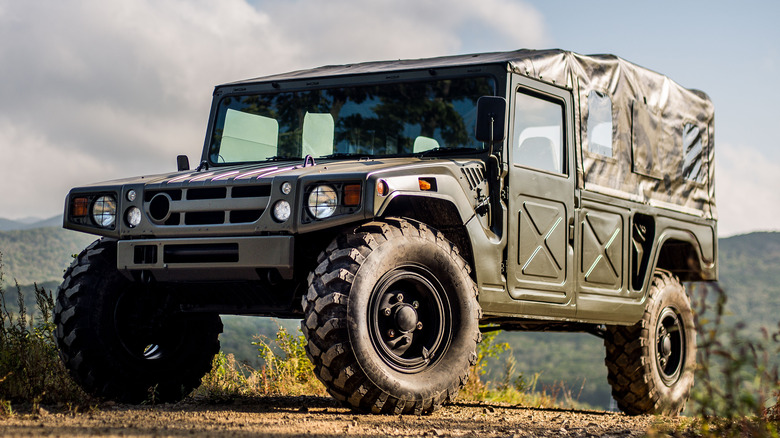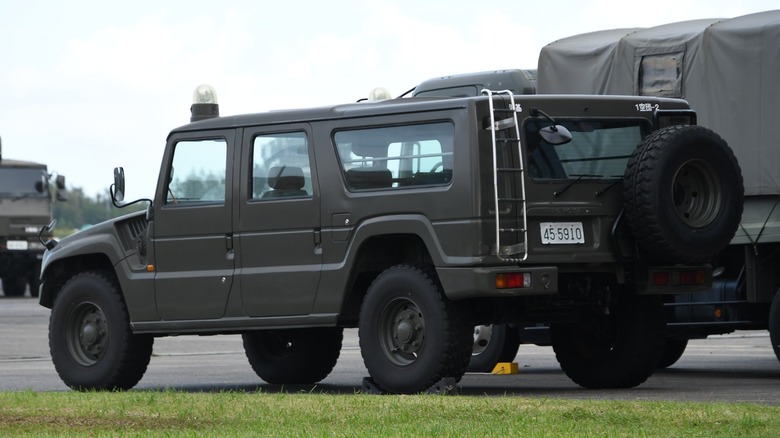How Toyota's Mega Cruiser Went Toe-To-Toe With Hummer
There's an old saying that imitation is the finest form of flattery. If true, then AM General — manufacturer of the military Humvee and its civilian counterpart, the Hummer H1 — must have felt mighty flattered in the mid-1990s when Toyota rolled out its Mega Cruiser. You would be excused for assuming that the Mega Cruiser — its name an escalation of the iconic Land Cruiser off-roader — was some sort of homebuilt kit car Hummer, except that the fit and finish are set to a traditionally high Japanese standard.
Defenders of the Mega Cruiser's copycat styling reason that the requirements of the Japanese military for the extreme-duty, all-terrain SUV would yield a similar vehicle to the Hummer, even if developed in a vacuum. We'll set that discussion aside for now, but suffice to say that the Mega Cruiser actually out-Hummered the Hummer in some respects. It's approximately two feet longer than the competition, up to 10 inches taller depending on roof design, and sports a half-inch more ground clearance.
The Toyota has another trick up its sleeve in the form of rear-wheel steering, which allows the rear tires to turn up to 12 degrees in either direction. Practically speaking, that means the giant truck has a turning radius of just 18.4 feet — less than a modern Toyota Camry, and more than eight feet tighter than the Humvee.
It was massively underpowered
Aside from the outsized dimensions and rear-wheel steering, the Mega Cruiser is similarly equipped to AM General's SUV: an engine mounted far back in the chassis, portal axles for extra ground clearance, an onboard tire inflation/deflation system, and full time all-wheel drive.
To afford such high ground clearance, the Mega Cruiser tucks its drivetrain high into the passenger compartment, resulting in a huge transmission tunnel dividing the occupants. Unlike the Hummer, at least, the supersize Toyota's transmission hump stopped short of the rear seat, allowing a whopping four-across bench seat to be fitted.
Under the Mega Cruisers expansive hood, we find an interesting choice in engine: a 4.1 liter four-cylinder turbocharged diesel. While 4.1 liters is big for a four-cylinder, it's still a four-cylinder. The output was rated at 153 horsepower and 282 pound-feet of torque, which is extremely underpowered for such a large and heavy machine.
How underpowered? According to Road & Track, accelerating from 0-60 MPH took an agonizing 20.6 seconds. In a recent test at altitude in the Colorado Rockies, a sample Mega Cruiser couldn't even reach 60 MPH — topping out at just 50 MPH with the throttle wide open.
As a consolation, the compact diesel was able to squeeze out 13 MPG in combined highway/city driving, which isn't exactly Prius-level fuel economy, but not awful either considering the size and weight of this monster.
[Featured image by Hunini via Wikimedia Commons | Cropped and scaled | CC BY-SA 4.0]
Expensive then and even more so today
Once again mimicking the arc of the Humvee, the Mega Cruiser was initially only available to the military and first responders, with a civilian version to follow for the Japanese Domestic Market (JDM) only. The consumer model started at 9,620,000 Yen — the dollar-equivalent of $85,000 (about $170,000 in today's money).
However, the initial purchase price was only the beginning of a pricey journey, because Japan's tax structure penalizes large vehicles with hefty registration fees. As a result, only 149 civilian Mega Cruisers were sold in total between 1995 and the end of production in 2002.
Fans of JDM cars will know that once a vehicle reaches 25 years old, it's legal to import into the United States, which is exactly what happened to one such Mega Cruiser in 2022. What's even more unique is that, prior to its new life in America, this particular vehicle was converted to left-hand drive in the United Arab Emirates. In a recent auction, it fetched a price as big as its personality: $314,500.

